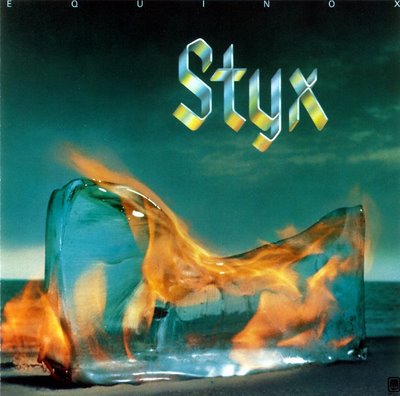
Equinox (1975)

1.Light Up
2.Lorelei
3.Mother Dear
4.Lonely Child
5.Midnight Ride
6.Born For Adventure
7.Prelude 12
8.Suite Madame Blue
For many, the true story of Styx begins here. Prior to this album’s release, a local Chicago radio station—spurred on a bit by the band themselves—dug up and resurrected Lady, a track from Styx II that had been all but forgotten. Upon its original release, the single went nowhere. But this time around, it shot straight into the Top 5. That success opened a few doors, but with only one hit to their name, the band still found themselves teetering on the edge of obscurity. Dennis DeYoung, feeling vindicated about the direction he’d long championed, took the reins creatively. They severed ties with Wooden Nickel, fired their management, and signed with A&M. From this point on, it was all uphill.
DeYoung dominates this record—writing and singing the bulk of the material—and wisely keeps the band rooted in accessible, straightforward rock. The album kicks off with Light Up, a bouncy, upbeat number that carries more than a hint of psychedelic euphoria. It’s one of the more risqué songs in their catalog, especially considering the band’s otherwise buttoned-up image. The follow-up is Lorelei, co-written with James Young, which remains a live staple and stands as one of the group’s defining early moments. Even Mother Dear, sung by John Curelewski, holds its own, again co-written by DeYoung. By the end of side one, with Lonely Child, the listener has heard more quality material than existed across all four of the band’s earlier records.
Side two opens with JY’s Midnight Ride, a ferocious rocker that veers into heavy territory. It’s as raw and powerful as anything they’d ever done and marks the high point of Young’s early contributions. Born for Adventure follows and became a natural choice to open their live sets for a stretch of years. But the showstopper is Suite Madame Blue, DeYoung’s six-and-a-half minute mini-epic that laid the groundwork for what would become the “Styx sound.” It begins softly before building into a thunderous crescendo—guitars, harmonies, and tympanis all in full force. A metaphor-laced reflection on American culture, the message is hardly subtle, but it’s delivered with such musical flair that it becomes unforgettable.
This album marked a clear turning point. For the first time, the band had decent production values, focused songwriting, and label support. With a solid album under their belts, they hit the road hard—over 200 shows in the next two years. The tide was turning, and people were finally starting to take notice.
Go back to the main page
Go To Next Review